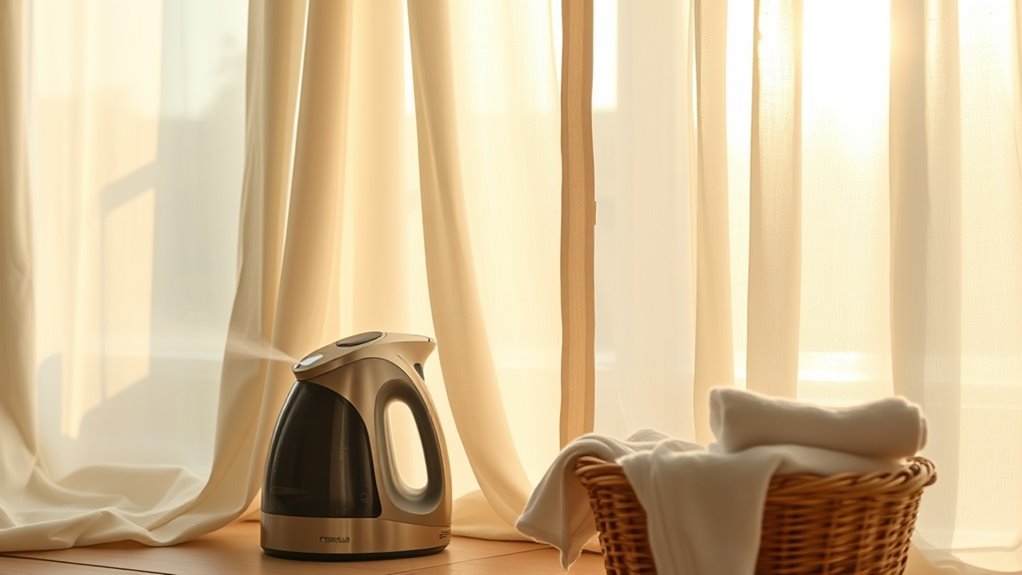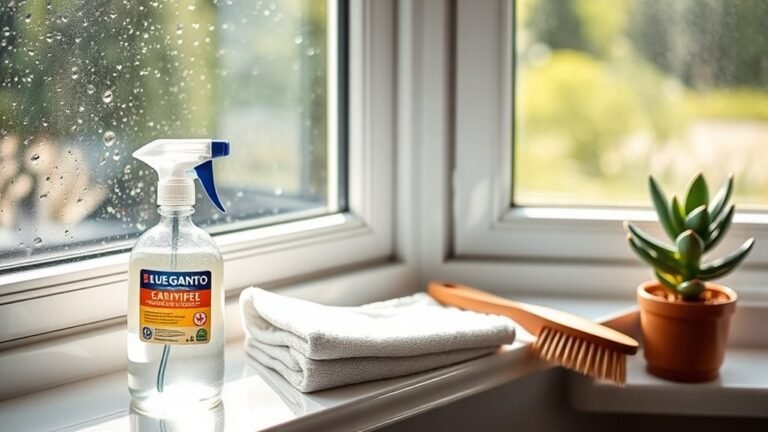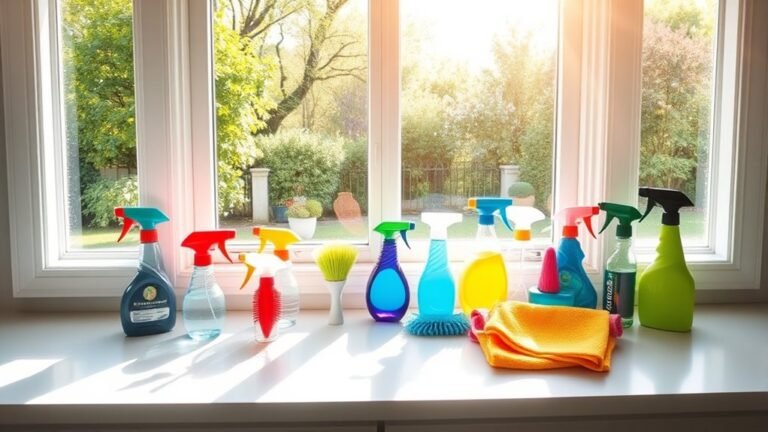Best Way to Sanitize Your Curtains
To sanitize your curtains effectively, first identify their fabric type to avoid damage—natural fibers need gentle care, synthetics can handle more robust methods. Begin by vacuuming or shaking off dust, then use natural disinfectants like diluted white vinegar or tea tree oil sprays. Machine wash durable fabrics on gentle cycles, hand wash delicate ones, and consider steam sanitizing to kill allergens without chemicals. Proper drying and moisture control prevent mold growth, extending freshness. Keep going to uncover tailored care tips that preserve your curtains longer.
Understanding Different Curtain Fabrics

Before you begin sanitizing your curtains, it’s important to understand the different fabric types you’re working with. Curtains come in various curtain types, including cotton, linen, polyester, silk, and blends—each demanding specific fabric care to maintain integrity and appearance. Natural fibers like cotton and linen absorb moisture readily, requiring gentle cleaning to avoid shrinkage or damage. Synthetic fabrics such as polyester offer more durability but can react adversely to high heat or harsh chemicals. Delicate materials like silk need specialized treatment to preserve texture and color. Recognizing the fabric guarantees you select an appropriate sanitizing method without compromising the curtain’s longevity. By mastering these nuances, you’ll confidently maintain your curtains’ freshness while safeguarding their structure and style, embracing the freedom to refresh your space effectively.
Preparing Curtains for Sanitization
Knowing your curtain fabric sets the stage for effective preparation steps that protect both the material and your home environment. Before sanitizing, inspect your curtains carefully to identify any delicate areas or stains that require special attention. When choosing materials for cleaning tools or solutions, opt for those compatible with your fabric type to avoid damage. Remove any hooks or hardware to prevent rust or corrosion during cleaning. Shake out or vacuum your curtains thoroughly to eliminate loose dust and dirt. If you plan to store curtains after sanitization, verify they are completely dry to prevent mold growth. Use breathable curtain storage bags or containers that protect from dust while allowing airflow. Proper preparation not only preserves your curtains but also enhances the sanitization process’s effectiveness and longevity.
Using Natural Cleaning Solutions

Although commercial cleaning products can be effective, using natural cleaning solutions offers a safer, eco-friendly alternative that’s gentle on your curtains and indoor air quality. You’ll want to choose natural disinfectants that eliminate germs without harsh chemicals, preserving fabric integrity while protecting your home environment. Here’s a quick guide to common eco friendly solutions:
| Natural Disinfectant | Benefits | Usage Tips |
|---|---|---|
| White Vinegar | Antimicrobial, deodorizes | Mix 1:3 with water, spray |
| Baking Soda | Absorbs odors, mild scrub | Sprinkle, let sit, vacuum |
| Tea Tree Oil | Antifungal, antibacterial | Add few drops to water |
| Lemon Juice | Natural bleach, freshens | Dilute, test on fabric patch |
Use these solutions regularly for effective, chemical-free sanitization that supports your freedom to live sustainably.
Machine Washing vs. Hand Washing Curtains
When deciding how to clean your curtains, you’ll want to weigh the benefits and drawbacks of machine washing versus hand washing to guarantee both cleanliness and fabric preservation. Machine washing offers convenience and efficiency, especially for durable fabrics, allowing you to sanitize large curtains quickly. However, it can be harsh on delicate materials, risking shrinkage or damage. Hand washing, though more time-consuming, gives you precise control over water temperature, detergent use, and agitation, making it ideal for fragile or antique fabrics. This method reduces wear and extends the life of your curtains while still effectively removing dirt and allergens. Ultimately, choose machine washing for sturdy curtains when you need speed; opt for hand washing when fabric integrity and gentle care are your priorities.
Steam Sanitizing Techniques

You’ll find steam sanitizing highly effective for eliminating bacteria and allergens without harsh chemicals. To steam your curtains properly, hold the steamer a few inches away and move it slowly to guarantee even coverage. This method not only refreshes fabric but also helps maintain its integrity over time.
Benefits of Steam Sanitizing
Because steam penetrates deep into fabric fibers, steam sanitizing offers a highly effective way to eliminate bacteria, dust mites, and allergens from curtains without using harsh chemicals. The steam benefits go beyond mere cleaning; they empower you to maintain a healthier living environment with minimal effort. Here are three sanitizing advantages steam provides:
- Chemical-free sanitation: Steam kills pathogens without leaving residues, preserving your curtains’ integrity and your freedom from toxins.
- Allergen reduction: It eradicates dust mites and pollen, essential for those sensitive to airborne irritants.
- Fabric preservation: Unlike harsh detergents, steam’s gentle heat refreshes fabrics without fading or wear.
How to Steam Curtains
Mastering three key steps will guarantee you steam your curtains effectively while preserving their quality. First, identify your curtain types—delicate fabrics like silk require low steam settings, while sturdier materials like cotton tolerate higher heat. Second, prepare your steamer by filling it with clean water and adjusting the steam settings according to the fabric’s tolerance. Third, position the steamer nozzle a few inches from the curtain, moving it slowly in vertical strokes to avoid water spots and ascertain even sanitization. Always test a small, hidden area first to confirm fabric resilience. By respecting these steps, you maintain your curtains’ integrity while eliminating germs and odors, granting you the freedom of a fresh, sanitized living space without compromising fabric longevity.
Tips for Maintaining Curtain Freshness Longer
To keep your curtains fresh longer, establish a regular dusting routine that prevents dirt buildup and allergens. Incorporate fabric fresheners designed for your curtain material to maintain a pleasant scent without causing damage. Also, be careful to avoid excessive moisture, which can promote mold growth and weaken fibers over time.
Regular Dusting Routine
Establishing a weekly dusting routine can greatly extend the freshness and appearance of your curtains. By adhering to specific dusting techniques and frequency guidelines, you’ll maintain your curtains’ vibrant look and free yourself from buildup that dulls fabric over time. Here’s how to do it effectively:
- Use a soft-bristle brush or a handheld vacuum with a brush attachment to gently remove dust without damaging fibers.
- Dust from top to bottom, ensuring you reach hidden folds and seams where dust accumulates.
- Follow a consistent weekly schedule to prevent excess dust, adapting frequency only if you notice faster dust buildup.
This disciplined approach empowers you to keep your curtains fresh longer without the need for frequent deep cleaning, preserving both fabric integrity and your freedom to enjoy a clean, inviting space.
Use Fabric Fresheners
Although regular dusting keeps your curtains visually clean, using fabric fresheners can greatly enhance their overall freshness and longevity between washes. Applying a quality fabric spray targets odors and revives the fabric’s scent without saturating the material. To maximize scent longevity, opt for sprays designed specifically for upholstery or curtains, as these contain ingredients that bind gently to fibers, releasing fragrance gradually. When using fabric fresheners, hold the spray about 12 inches away and mist lightly, ensuring even coverage without soaking the fabric. This method helps maintain a pleasant ambiance and reduces the frequency of full cleanings, giving you more freedom to enjoy your space. Incorporate fabric fresheners into your routine to keep your curtains smelling fresh longer while preserving their texture and appearance.
Avoid Excessive Moisture
Since curtains are often made from delicate fabrics, you’ll want to avoid excessive moisture that can lead to mold, mildew, and fabric deterioration. Effective moisture control is essential for ideal fabric care and curtain longevity. Here’s how you can maintain your curtains’ freshness and freedom from damage:
- Use a dehumidifier in rooms prone to high humidity to prevent moisture buildup.
- Guarantee proper ventilation by opening windows or using exhaust fans, especially after showers or cooking.
- Avoid washing curtains with overly wet cycles; instead, opt for gentle washing and thorough drying.
Frequently Asked Questions
Can Sanitizing Curtains Help Reduce Allergy Symptoms?
Yes, sanitizing curtains can greatly help reduce allergy symptoms. Curtains often trap allergy triggers like dust mites, which can worsen your reactions. By regularly sanitizing them, you remove these microscopic irritants, improving your indoor air quality and making your space more comfortable. You’ll enjoy greater freedom from sneezing and congestion, letting you breathe easier and live more freely without the constant burden of allergens lurking in your home environment.
How Often Should I Sanitize Curtains in a High-Traffic Area?
Did you know dust mites can double in number every two weeks in high-traffic areas? For frequency recommendations, sanitize your curtains at least once a month to keep allergens in check. Use cleaning methods like steam cleaning or washing with mild detergent, which effectively removes bacteria without damaging fabric. By maintaining this routine, you’ll enjoy a fresher, healthier living space while still feeling free from constant, overwhelming chores.
Are There Specific Sanitizers Safe for Kids and Pets?
You’ll want to choose natural alternatives and child safe products when sanitizing around kids and pets. Look for sanitizers with ingredients like vinegar, baking soda, or essential oils—they’re effective yet gentle. Avoid harsh chemicals like bleach or ammonia, which can be harmful. Always check labels to verify the product is non-toxic and specifically designed for households with children and animals. This way, you maintain a safe, clean environment without sacrificing your freedom to use effective sanitizers.
Can UV Light Be Used to Sanitize Curtains Effectively?
You can use UV light to sanitize curtains, but its UV effectiveness depends heavily on curtain materials. Dense or dark fabrics may block UV rays, reducing sanitization efficiency. UV light works best on smooth, thin, or sheer fabrics where rays penetrate easily. Remember, UV sanitizing won’t remove dirt or allergens, so combine it with regular cleaning. Always guarantee safe exposure times to avoid fabric damage and maintain your freedom to keep curtains fresh.
Does Sanitizing Curtains Affect Their Color or Texture?
You might not expect it, but sanitizing your curtains can sometimes impact their color or texture if done improperly. To guarantee color preservation and texture maintenance, always choose gentle methods—like using mild detergents or steam cleaning—avoiding harsh chemicals or excessive heat. This way, you keep your curtains vibrant and soft, preserving their look and feel while enjoying the freedom of a clean, healthy environment.






